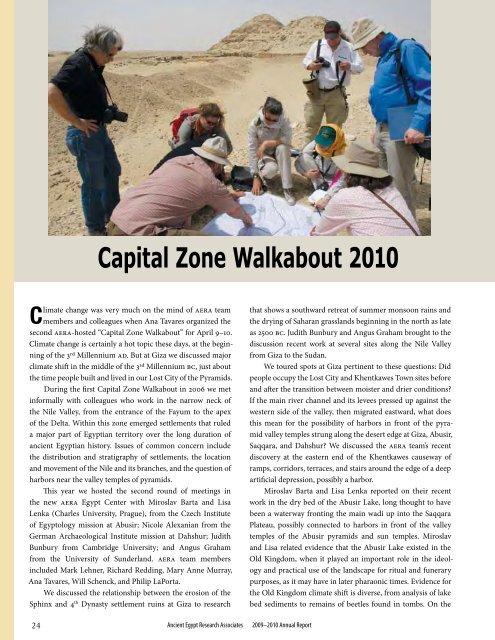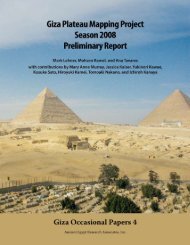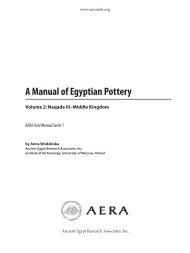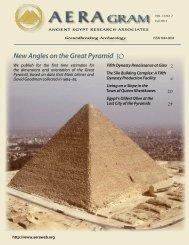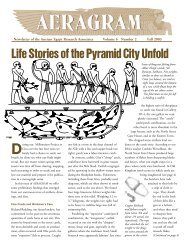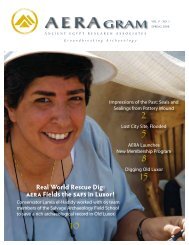Download a PDF of our 2010 Annual Report - Ancient Egypt ...
Download a PDF of our 2010 Annual Report - Ancient Egypt ...
Download a PDF of our 2010 Annual Report - Ancient Egypt ...
You also want an ePaper? Increase the reach of your titles
YUMPU automatically turns print PDFs into web optimized ePapers that Google loves.
24<br />
Capital Zone Walkabout <strong>2010</strong><br />
Climate change was very much on the mind <strong>of</strong> AERA team<br />
members and colleagues when Ana Tavares organized the<br />
second AERA-hosted “Capital Zone Walkabout” for April 9–10.<br />
Climate change is certainly a hot topic these days, at the beginning<br />
<strong>of</strong> the 3rd Millennium AD. But at Giza we discussed major<br />
climate shift in the middle <strong>of</strong> the 3rd Millennium BC, just about<br />
the time people built and lived in <strong>our</strong> Lost City <strong>of</strong> the Pyramids.<br />
During the first Capital Zone Walkabout in 2006 we met<br />
informally with colleagues who work in the narrow neck <strong>of</strong><br />
the Nile Valley, from the entrance <strong>of</strong> the Fayum to the apex<br />
<strong>of</strong> the Delta. Within this zone emerged settlements that ruled<br />
a major part <strong>of</strong> <strong>Egypt</strong>ian territory over the long duration <strong>of</strong><br />
ancient <strong>Egypt</strong>ian history. Issues <strong>of</strong> common concern include<br />
the distribution and stratigraphy <strong>of</strong> settlements, the location<br />
and movement <strong>of</strong> the Nile and its branches, and the question <strong>of</strong><br />
harbors near the valley temples <strong>of</strong> pyramids.<br />
This year we hosted the second round <strong>of</strong> meetings in<br />
the new AERA <strong>Egypt</strong> Center with Miroslav Barta and Lisa<br />
Lenka (Charles University, Prague), from the Czech Institute<br />
<strong>of</strong> <strong>Egypt</strong>ology mission at Abusir; Nicole Alexanian from the<br />
German Archaeological Institute mission at Dahshur; Judith<br />
Bunbury from Cambridge University; and Angus Graham<br />
from the University <strong>of</strong> Sunderland. AERA team members<br />
included Mark Lehner, Richard Redding, Mary Anne Murray,<br />
Ana Tavares, Will Schenck, and Philip LaPorta.<br />
We discussed the relationship between the erosion <strong>of</strong> the<br />
Sphinx and 4th Dynasty settlement ruins at Giza to research<br />
<strong>Ancient</strong> <strong>Egypt</strong> Research Associates 2009–<strong>2010</strong> <strong>Annual</strong> <strong>Report</strong><br />
that shows a southward retreat <strong>of</strong> summer monsoon rains and<br />
the drying <strong>of</strong> Saharan grasslands beginning in the north as late<br />
as 2500 BC. Judith Bunbury and Angus Graham brought to the<br />
discussion recent work at several sites along the Nile Valley<br />
from Giza to the Sudan.<br />
We t<strong>our</strong>ed spots at Giza pertinent to these questions: Did<br />
people occupy the Lost City and Khentkawes Town sites before<br />
and after the transition between moister and drier conditions?<br />
If the main river channel and its levees pressed up against the<br />
western side <strong>of</strong> the valley, then migrated eastward, what does<br />
this mean for the possibility <strong>of</strong> harbors in front <strong>of</strong> the pyramid<br />
valley temples strung along the desert edge at Giza, Abusir,<br />
Saqqara, and Dahshur? We discussed the AERA team’s recent<br />
discovery at the eastern end <strong>of</strong> the Khentkawes causeway <strong>of</strong><br />
ramps, corridors, terraces, and stairs around the edge <strong>of</strong> a deep<br />
artificial depression, possibly a harbor.<br />
Miroslav Barta and Lisa Lenka reported on their recent<br />
work in the dry bed <strong>of</strong> the Abusir Lake, long thought to have<br />
been a waterway fronting the main wadi up into the Saqqara<br />
Plateau, possibly connected to harbors in front <strong>of</strong> the valley<br />
temples <strong>of</strong> the Abusir pyramids and sun temples. Miroslav<br />
and Lisa related evidence that the Abusir Lake existed in the<br />
Old Kingdom, when it played an important role in the ideology<br />
and practical use <strong>of</strong> the landscape for ritual and funerary<br />
purposes, as it may have in later pharaonic times. Evidence for<br />
the Old Kingdom climate shift is diverse, from analysis <strong>of</strong> lake<br />
bed sediments to remains <strong>of</strong> beetles found in tombs. On the


